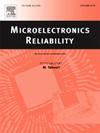基于贝叶斯正则化的板级跌落冲击下互连结构力学响应识别
IF 1.6
4区 工程技术
Q3 ENGINEERING, ELECTRICAL & ELECTRONIC
引用次数: 0
摘要
为了解决直接测量电路板级封装结构中关键互连结构的机械响应的挑战,这一挑战由于电子元件的固有复杂性而变得复杂,本研究首次提出了一种负载识别方法。该方法建立在有限元分析的基础上,以准确识别板级封装关键互连结构的关键失效点。此外,提出了一种基于贝叶斯正则化的间接测量方法用于载荷识别,以全面捕捉板级封装结构中关键结构部件在跌落冲击下的应力状况。在冲击过程中,边缘区域下方角落处的焊点承受最大的应力和应变,使其更容易失效。垂直于印刷电路板(PCB)的z方向(S33)的法向应力是最大应力分量,是导致互连结构损坏的主要原因。针对载荷识别中的不适定问题,如由病态矩阵的反演引起的不稳定性和对噪声的敏感性,引入了一种改进的贝叶斯方法,该方法采用增广吉洪诺夫正则化。该方法采用小波阈值化技术,解决了高噪声条件下负载识别精度差的问题。该算法在识别过程中自适应确定最优正则化参数,有效地消除了噪声对负荷识别的影响。所建立的响应识别方法能够在识别板级封装结构中关键互连的机械响应时实现相对较小的相对误差(RE)和高相关系数。同时保证了响应曲线的平滑性和峰值识别的准确性。同时考虑了输入点个数的变化对识别结果的影响。结果表明,输入点越多,约束越有效,识别精度越高。在双输入条件下,在中低噪声水平下,RE控制在8%以下,在高噪声水平下,RE保持在10%以下,为跌落冲击过程中的有效应力分析提供了有效方法。本文章由计算机程序翻译,如有差异,请以英文原文为准。
Identification of mechanical responses of interconnect structures based on Bayesian regularization under board-level drop impact
To address the challenge of directly measuring the mechanical response of critical interconnect structures in board-level packaging structures, which is complicated by the inherent complexity of electronic components, a load identification methodology is first proposed in this study. This methodology is established based on finite element (FE) analysis to accurately identify the critical failure points in the key interconnect structures of board-level packaging. Furthermore, an indirect measurement method based on Bayesian regularization is proposed for load identification to comprehensively capture the stress conditions of critical structural components in the board-level packaging structures subjected to drop impact. During the impact process, the solder joints at the corners beneath the edge areas experience the maximum stress and strain, making them more prone to failure. The normal stress in the Z-direction (S33) perpendicular to the printed circuit board (PCB), which is the maximum stress component, is the primary cause of damage to the interconnect structure. To address the ill-posed problem in load identification, such as the instability due to the inversion of ill-conditioned matrices and sensitivity to noise, an improved Bayesian method using augmented Tikhonov regularization is introduced. The proposed method incorporates a wavelet thresholding technique to solve the problem of poor load identification accuracy under high noise levels. It adaptively determines the optimal regularization parameters during the identification process and effectively removes the noise impact on load recognition. The established response identification methodology is capable of achieving relatively small relative error (RE) and high correlation coefficients when identifying the mechanical response of critical interconnections in board-level packaging structures. Furthermore, both the smoothness of the response curve and the accuracy of peak value identification are ensured. The effect of varying numbers of input points on the identification results is also considered. The results show that more input points provide more effective constraints, thereby improving recognition accuracy. Under dual-input conditions, the RE is controlled below 8 % at medium to low noise levels, and remains below 10 % at high noise levels, providing an effective approach for effective stress analysis during the drop impact process.
求助全文
通过发布文献求助,成功后即可免费获取论文全文。
去求助
来源期刊

Microelectronics Reliability
工程技术-工程:电子与电气
CiteScore
3.30
自引率
12.50%
发文量
342
审稿时长
68 days
期刊介绍:
Microelectronics Reliability, is dedicated to disseminating the latest research results and related information on the reliability of microelectronic devices, circuits and systems, from materials, process and manufacturing, to design, testing and operation. The coverage of the journal includes the following topics: measurement, understanding and analysis; evaluation and prediction; modelling and simulation; methodologies and mitigation. Papers which combine reliability with other important areas of microelectronics engineering, such as design, fabrication, integration, testing, and field operation will also be welcome, and practical papers reporting case studies in the field and specific application domains are particularly encouraged.
Most accepted papers will be published as Research Papers, describing significant advances and completed work. Papers reviewing important developing topics of general interest may be accepted for publication as Review Papers. Urgent communications of a more preliminary nature and short reports on completed practical work of current interest may be considered for publication as Research Notes. All contributions are subject to peer review by leading experts in the field.
 求助内容:
求助内容: 应助结果提醒方式:
应助结果提醒方式:


